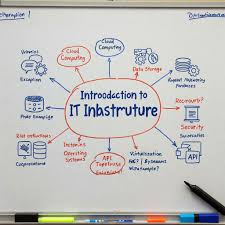Whether you're building your first web app or deploying a full-stack SaaS product, IT infrastructure is the backbone that brings your code to life. For new developers, infrastructure might sound intimidating—but understanding the basics will give you a serious edge in the world of software development.
In this guide, we’ll break down what IT infrastructure is, why it matters, and how you can start navigating servers, networks, and deployment environments like a pro.
🚀 What is IT Infrastructure?
IT Infrastructure refers to the set of physical and virtual components that support software systems and services. Think of it as everything beneath the code—the tech stack that powers your app behind the scenes.
Core Components of IT Infrastructure:
| Component | Description |
|---|---|
| Hardware | Physical devices like servers, routers, and storage units |
| Software | Operating systems, server software, and middleware |
| Network | The connectivity layer: routers, DNS, firewalls, internet |
| Data Storage | Databases, file systems, and cloud buckets |
| Compute | CPUs, virtual machines, containers that run your code |
| Security | Firewalls, SSL/TLS, IAM (Identity & Access Management) |
🧠 Why Developers Should Learn IT Infrastructure
You might think: “I’m a developer, not a sysadmin.” But in 2025, the line between dev and infra is blurred. Understanding infrastructure helps you:
-
Deploy your code effectively
-
Debug issues faster
-
Optimize app performance
-
Ensure security & compliance
-
Collaborate better with DevOps teams
If you're building or contributing to real-world apps, infrastructure is part of the game.
🏗️ Types of Infrastructure Environments
As a beginner, you’ll interact with different types of environments throughout the software lifecycle:
| Environment | Purpose |
|---|---|
| Local | Your personal dev machine where code is written and tested |
| Development | Shared testing environment for teams |
| Staging | A pre-production environment that mimics the live app |
| Production | The live, user-facing version of your app |
🛠️ Essential Tools & Concepts for Beginners
1. Web Servers
-
Software that serves your web content
-
Popular: Nginx, Apache, Caddy
2. Databases
-
Where your app stores data
-
SQL: MySQL, PostgreSQL
-
NoSQL: MongoDB, Redis
3. Operating Systems
-
Most servers run Linux (Ubuntu, Debian, CentOS)
-
Learn basic Linux commands and file systems
4. Cloud Providers
-
Host and scale your infrastructure
-
Try: AWS (Free Tier), DigitalOcean, Render, Vercel
5. Containers & Virtualization
-
Docker lets you bundle code and dependencies
-
Kubernetes manages containerized apps (intermediate+)
6. Version Control
-
Track your infrastructure setup
-
Use Git + GitHub or GitLab
🌐 Introduction to Networking Basics
Understanding networking helps you secure and scale apps:
| Concept | Description |
|---|---|
| IP Address | Identifies a machine on a network |
| DNS | Converts domain names to IP addresses |
| Firewall | Controls incoming and outgoing traffic |
| Ports | Gateways for different services (e.g., 80 for HTTP, 443 for HTTPS) |
🔐 Security Fundamentals
Don’t ship insecure apps! As a dev, know these basics:
-
SSL Certificates: Encrypt communication (via HTTPS)
-
SSH: Secure shell access to servers
-
Environment Variables: Store secrets securely
-
Access Control: Limit server and DB access by user roles
☁️ Cloud Infrastructure for Beginners
Cloud providers make it easy to manage infrastructure:
| Cloud Tool | Purpose |
| EC2 / Droplets | Virtual servers |
| S3 / Buckets | File storage |
| RDS / Managed DB | Hosted databases |
| Lambda / Cloud Functions | Serverless compute |
🧰 Build Your First Infrastructure Setup
Here’s a simple stack to try:
-
Frontend: React app
-
Backend: Node.js API
-
Database: PostgreSQL on Render
-
Hosting: Vercel for frontend, Render for backend
-
Domain: Use Cloudflare or Namecheap for DNS
-
HTTPS: Enable free SSL via Let’s Encrypt
You can deploy this with minimal config and still get real-world experience.
🎓 Learn by Doing: Project Ideas
-
Personal Portfolio with Nginx and SSL
-
CRUD App with Node.js, Docker, and PostgreSQL
-
Static Blog with GitHub Pages or Netlify
-
API + Dashboard with Vercel + Supabase
🏁 Final Thoughts
IT Infrastructure doesn’t have to be overwhelming. Start small. Learn by deploying. Break things. Fix them. Each project teaches you more about how apps live and breathe in the real world.
By mastering the foundations now, you’ll be better prepared for advanced topics like scalability, security audits, or full-stack DevOps workflows later.
✅ Quick Takeaways
-
IT infrastructure is everything behind your code: servers, networks, databases
-
Learn tools like Linux, Docker, Git, and cloud hosting
-
Know your environments: dev, staging, production
-
Prioritize security and automation early
-
Experiment with cloud platforms like AWS, Render, or Vercel
💬 Got Questions?
Drop your comments below or share your setup on Twitter (X), Facebook, or Linkedin. We’d love to see what you’re building.




Leave a Reply